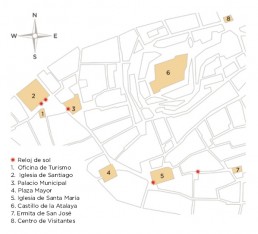The historic center of Villena has an interesting set of solar watches that due to their age and uniqueness constitute a clear example of the richness and diversity of their historical heritage. Its chronology covers from the end of the 16th century to the 18th century.
Three of them are preserved in the Plaza de Santiago, two around the front of the church of Santiago and one on the facade of the Municipal Palace. A fourth copy is found on the facade of the bell tower of the church of Santa María.
We have evidence of the existence of other sundials in the urban center of Villena, now disappeared, such as the one that was in the Clock Tower or the Orejón, demolished in 1888, or the one that was located in the hermitage of Santa Lucía, at the entrance of the city.
Arcedianal Churc of Santiago
On the southeast façade of the church of Santiago, with an orientation of 41º to the east, is the oldest of the sundials preserved in the historic center of Villena, which we can place at the end of the 16th century. This is the semicircular clock with perpendicular rod located to the right of the cover whose design is not valid for this orientation. Apparently, an attempt was made to unsuccessfully adapt a design for a southern orientation to the decline of this facade, obviating the inclination of the gnomon, and turning it slightly counterclockwise. Therefore, although finally carved, it can not work properly. Soon after, the clock on the cover must have been made, this time perfectly resolved for the orientation of the façade. Under the slogan "BRIEF DIES HOMINIS SVNT" (Brief are the days of man), the clock contains the hours from 4:00 to 15:00 and is even with the clock located on the facade of the Municipal Palace, at approximately 90º , which contains the hours from 9:00 to 20:00.
Palacio Municipal
To complete the schedule that offers the clock on the facade of the church of Santiago and comfortably cover the remaining hours of the day, on the facade of the Municipal Palace (former abbey house of the church), with an orientation of 47º to the west, a second sundial was made with the slogan "SIC TRANSIT GLORIA HVIVIS MVNDI" (This is the glory of this world).
Larger and located higher than the church of Santiago, this clock retains the start of a decoration architectural at the top, interrupted by some of the reforms made in the building throughout its history. Another peculiarity is the line carved above the 10 o'clock line, which probably corresponds to an auxiliary line for calculating the clock.
Santa Maria´s curch
The bell tower of the church of Santa María was completed at the end of the 17th century. On its west façade, with an orientation of 73º to the west, there is its corresponding sundial, recently recovered. Unlike those in the Plaza de Santiago, carved on the stone surface, this copy is painted on the wall. Its striking design, adapted to its high declination, and its perpendicular gnomon that indicates the hours with the shadow of its pointed end, make it a very singular specimen. Indicates the afternoon hours, starting at solar noon.


